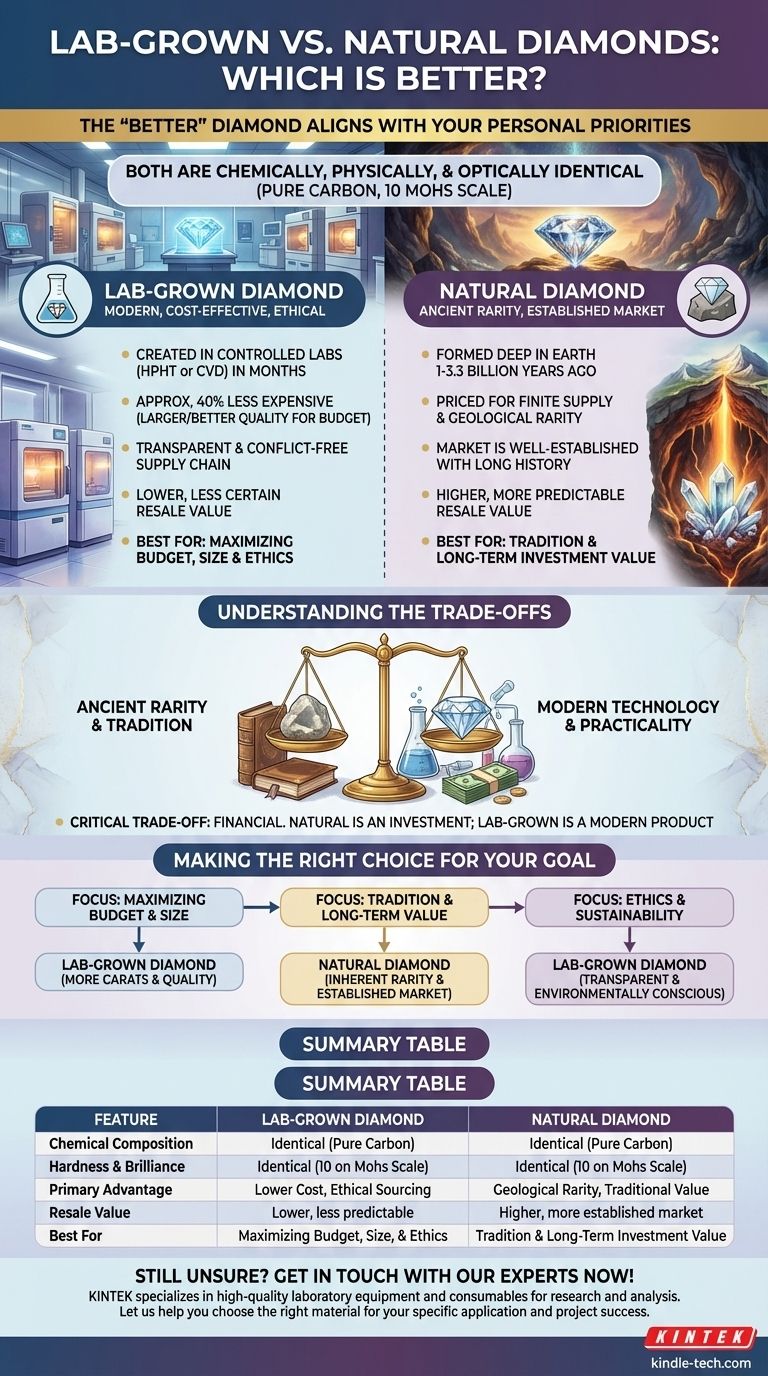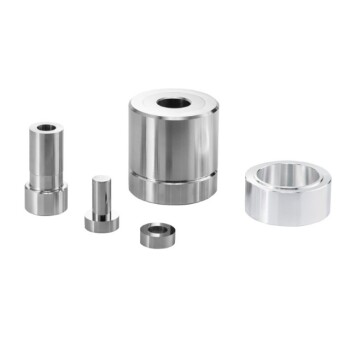The "better" diamond is the one that aligns with your personal priorities, as both lab-grown and natural diamonds are chemically, physically, and optically identical. Natural diamonds offer the allure of geological rarity formed over billions of years, while lab-grown diamonds provide the same brilliance and hardness for a significantly lower price, often with a more transparent supply chain. A lab-grown diamond is not a "fake" diamond; it is a real diamond created in a controlled environment.
The decision between a lab-grown and a natural diamond is not about choosing a "real" versus a "fake" stone. It is a choice between two value propositions: the ancient rarity and established market of a natural diamond versus the modern, cost-effective, and ethical advantages of a lab-grown one.

What Is the Actual Difference?
To make an informed decision, you must first understand that the core properties of both diamonds are the same. The distinctions lie entirely in their origin and the resulting market perception.
They Are Chemically and Optically Identical
A lab-grown diamond is not a simulant like cubic zirconia. It shares the exact same chemical composition (pure carbon), crystal structure, and physical properties as a mined diamond.
This means they have the same hardness (a 10 on the Mohs scale), the same brilliance, and the same fire. To the naked eye, even side-by-side, they are physically indistinguishable.
The Key Difference Is Origin
The primary distinction is how they were formed. Natural diamonds were created deep within the Earth's mantle between 1 and 3.3 billion years ago under immense heat and pressure before being brought to the surface by volcanic eruptions.
Lab-grown diamonds are created in highly controlled laboratory environments that replicate these conditions. The two main methods are High Pressure/High Temperature (HPHT) and Chemical Vapor Deposition (CVD), which typically take a few months from start to finish.
How Experts Tell Them Apart
While they look identical to you, a trained gemologist using specialized equipment can distinguish between them. This is done by identifying microscopic differences in their crystal growth patterns and the types of inclusions they contain.
These subtle markers, which are invisible without magnification, serve as a "fingerprint" of the diamond's formation process—either natural and chaotic or man-made and controlled.
Comparing the Core Value Propositions
Your decision will ultimately hinge on which factors you value most: budget, rarity, or ethical considerations.
Price and Size: The Major Divider
This is the most significant practical difference for most buyers. A lab-grown diamond is approximately 40% less expensive than a natural diamond of the same size and quality.
This price difference allows you to purchase a significantly larger or higher-quality (better cut, color, or clarity) diamond for the same budget.
Rarity and Resale Value
Natural diamonds derive much of their value from their finite supply and geological rarity. Their market is well-established, and they have a long history as a store of value, giving them a more predictable, albeit not guaranteed, resale market.
Lab-grown diamonds can be produced on demand, meaning they are not rare. As production technology becomes more efficient, their prices may continue to decrease over time. Consequently, their long-term resale value is less certain and currently much lower than that of natural diamonds.
Ethics and Environmental Impact
The origin of lab-grown diamonds is fully traceable, offering a clear and conflict-free supply chain. This avoids the historical issues of "blood diamonds" associated with some mining operations.
Furthermore, proponents argue that diamond creation in a lab has a reduced environmental footprint compared to large-scale mining operations, making it a more sustainable choice.
Understanding the Trade-offs
There is no perfect choice, only a series of trade-offs. Being aware of them is key to making a decision you will be happy with for years to come.
The Allure of Ancient Rarity
For many, the value of a natural diamond is deeply tied to its story. It is a unique, billion-year-old piece of Earth's history. This romantic and traditional appeal cannot be replicated by technology.
The Practicality of Modern Technology
A lab-grown diamond represents a pragmatic choice. You get a visually identical, chemically real diamond with superior characteristics for your money. It prioritizes the physical beauty and size of the stone over its geological origin.
The Question of Long-Term Value
The most critical trade-off is financial. A natural diamond is an investment in a rare, natural gem with an established history of holding value. A lab-grown diamond is a purchase of a beautiful, modern product whose primary value is its aesthetic quality and lower initial cost, not its long-term financial worth.
Making the Right Choice for Your Goal
Ultimately, the "better" diamond is a reflection of your personal values.
- If your primary focus is maximizing budget and size: A lab-grown diamond is the clear and logical choice, offering more carats and quality for your dollar.
- If your primary focus is tradition and long-term value: A natural diamond holds the advantage due to its inherent rarity and established position in the market.
- If your primary focus is ethics and sustainability: A lab-grown diamond provides a transparent origin and a more environmentally conscious alternative to traditional mining.
The best diamond is the one that you will wear with confidence and pride, knowing it perfectly aligns with what matters most to you.
Summary Table:
| Feature | Lab-Grown Diamond | Natural Diamond |
|---|---|---|
| Chemical Composition | Identical (Pure Carbon) | Identical (Pure Carbon) |
| Hardness & Brilliance | Identical (10 on Mohs Scale) | Identical (10 on Mohs Scale) |
| Primary Advantage | Lower Cost (≈40% less), Ethical Sourcing | Geological Rarity, Traditional Value |
| Resale Value | Lower, less predictable | Higher, more established market |
| Best For | Maximizing Budget, Size, & Ethics | Tradition & Long-Term Investment Value |
Still unsure which diamond is right for your specific application?
Whether you're conducting material analysis, research, or require diamonds for industrial use, choosing the right type is critical for your project's success. At KINTEK, we specialize in providing high-quality laboratory equipment and consumables to support your work.
Our experts can help you understand the best material for your needs, ensuring precision and reliability in your lab. Contact us today to discuss your requirements and discover how KINTEK's solutions can enhance your laboratory's capabilities.
Get in touch with our experts now!
Visual Guide

Related Products
- 915MHz MPCVD Diamond Machine Microwave Plasma Chemical Vapor Deposition System Reactor
- HFCVD Machine System Equipment for Drawing Die Nano-Diamond Coating
- Inclined Rotary Plasma Enhanced Chemical Vapor Deposition PECVD Equipment Tube Furnace Machine
- CVD Diamond Domes for Industrial and Scientific Applications
- CVD Diamond Cutting Tool Blanks for Precision Machining
People Also Ask
- What is microwave plasma CVD? A Guide to High-Purity Diamond and Material Synthesis
- What is MPCVD? Unlock Atom-by-Atom Precision for High-Purity Materials
- How does chemical vapor deposition work for diamonds? Grow Lab-Created Diamonds Layer by Layer
- What is the microwave plasma method? A Guide to High-Purity Material Synthesis
- What are the limitations of diamonds? Beyond the Myth of Perfection



















